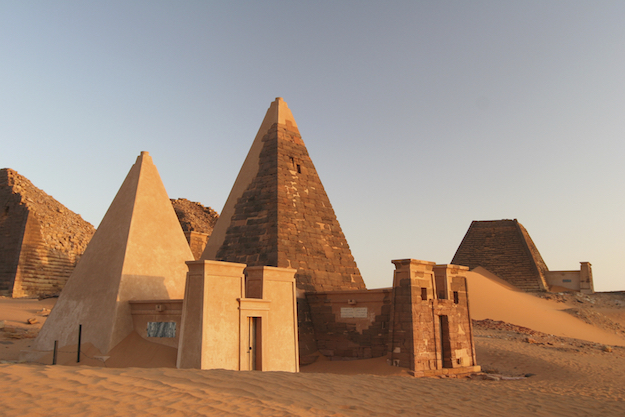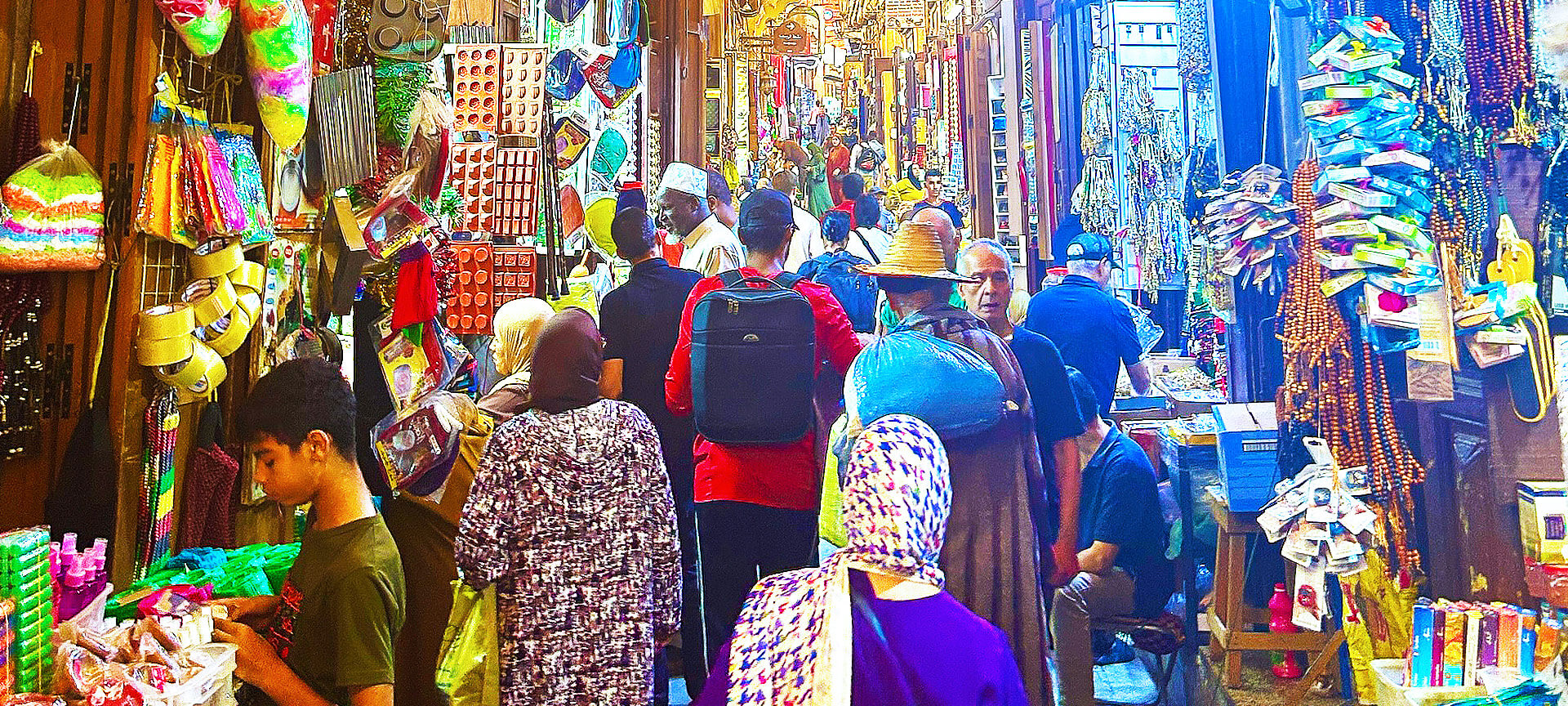"Two roads diverged in a wood and I - I took the one less traveled by, and that has made all the difference." - Robert Frost
Before air travel became overly popular, it was easy to feel you were on the road less travelled. Since the development of the jet engine in the 1950s flying has become more commonplace, making it quicker and easier each year to see destinations you’ve been yearning over.
 The Meroe Pyramids, sometimes referred to as the Nubian pyramids, are located along the banks of the Nile River in the lonely desert of eastern Sudan. There are nearly 200 known pyramids there, and they were built between 2,300 and 2,700 years ago, with many of the pyramids functioning as tombs for the royalty of the Meroitic kingdom.
The Meroe Pyramids, sometimes referred to as the Nubian pyramids, are located along the banks of the Nile River in the lonely desert of eastern Sudan. There are nearly 200 known pyramids there, and they were built between 2,300 and 2,700 years ago, with many of the pyramids functioning as tombs for the royalty of the Meroitic kingdom.However, that means everyone else has been able to get to those far flung destinations too. We all know the feeling of arriving and finding out that you are undoubtedly not alone. The unbearable throngs of people all trying to see that one monument, places bursting at the seams as unending streams of people flow in and out of its city walls.
To shine a little light on places still under the radar, we wanted to share our top five underrated destinations where you’ll likely have the monuments, museums, beaches and nature paths all to yourself.
- Sudan and Djibouti Tours
With more pyramids than Egypt, Sudan shines when discovering the ancient Pharaonic civilizations.
Sandy hills engulf much of the landscape, which is broken up with patches of acacia tree forests, the black basalt mountains in the Bayuda Mountains, a red sandstone holy mountain found in Jebel Barkal and the twisting turning Nile Rivers that flow along the country until converging in Khartoum.
On the banks of the Nile, local life blossoms alongside archeological sites. Nubian culture, which has inhabited the Nile Region since 2000 BC, is one of the oldest civilizations known to inhabit the African continent. Relics, such as the temple dedicated to Amon at the base of Jebel Barkal, were once the religious centre of Nubia for 1000 years, whereas the political centre was spread to numerous locations, such as the ancient city of Napata with a royal necropolis decorated fully with colourful hieroglyphics.
Modern Nubian culture thrives in hospitality, and joining a village for a cup of tea is an experience that still feels natural.
Near to Sudan and included in our tours to the region, Djibouti's well off the beaten track. Often compared to Iceland in terms of diverse landscapes, the small country has scenic salt lakes, extinct volcanoes, recessed plains, basaltic plateaus and impressive canyons. - Mayotte - Comoros Islands
Far flung islands within the Indian Ocean, the Comoros archipelago doesn’t attract the traveller looking for a typical beach holiday. The remote location sees few tourists but locals enjoy plenty of natural beauty in what many consider the most scenic island in the Indian Ocean.
Mayotte inherited a very diverse culture. Conquered in the 15th century by the Arabs, visited in the 16th century by the Portuguese and French, and invaded in the 18th century by the Sakalava, a Malagasy tribe from Madagascar. The French gained colonial control over Mayotte in 1843, and, together with the other islands of the Comoros archipelago and Madagascar, Mayotte became part of a single French overseas territory in the early 20th century.
Find sprawling beaches with soft white sand, while inland active volcanoes create fertile lands producing crops such as vanilla, ylang-ylang, coffee, banana and coconuts. Spot lemurs and giant fruit bats near the baobab trees, a tree species which appear as though the roots are growing into the sky which is endemic to Mayotte, Madagascar and parts of the African continent. - The Balkans: Macedonia and Kosovo
The Balkan Peninsula is the last corner of Europe to see tourists.
Located near the Adriatic, Mediterranean and Black Seas, The Balkans have been at the crossroads of great civilizations since antiquity. Greek, Roman and Ottoman relics are still visible to this day.
In Kosovo, a newly recognized country since 2008, one can view Ottoman legacies such as the Sinan Pasha Mosque built in 1561, the Carshia Mosque in Pristina constructed in the 15th century, and the Ottoman clock towers built in the 19th century in the city of Pristina. Showcasing the Serbian Orthodox minority are monasteries such as the Decani Monastery, which is considered to be one of the best preserved medieval monasteries in Kosovo or the Gracanica Monastery, built in 1321 and representing the height of Serbian Byzantine tradition.
Follow twisting mountain roads to peaceful cobblestoned town squares with beautiful vistas. Cafe culture is alive and well in Kosovo, and while evidence of the conflicts from the 1990s are visible across the country, it feels as though that time is well in the past.
In Macedonia, the country transitions seamlessly from the jigsaw puzzle of buildings in Skopje, which has been ruled at various times by ancient Rome, Byzantium, the First Bulgarian Empire and the Ottoman Turks, to the stunningly scenic towns such as Ohrid. Perched on the northern slopes above Lake Ohrid, the “city of 365 churches" is home to monasteries dating back to the 9th century which were once the cradle of arts and literature, even creators of the Cyrillic language. - South Pacific Islands - Nauru, Tuvalu, Kiribati
You’d be forgiven if you had to reference a map to discover where the islands of Nauru, Tuvalu and Kiribati are.
In Kiribati, fewer than 6000 visitors reached its shores, making it the 4th least visited country in the world. Tuvalu sees even less tourists, just under 1000 per year, while Nauru holds the distinction of being the least visited country in the world with fewer than 160 visitors per year.
Extremely remote, these near inaccessible islands are found between New Zealand and Hawaii, and boast a wonderful Polynesian culture. In Kiribati, Micronesians speak the same Oceanic language since perhaps as far back as 3000 BC. Throughout history, arrivals from Samoa, Tonga, and Fiji have impacted the 'cultural landscape'.
Climate change is a real issue facing all three countries. Rising sea levels are expected to submerge the islands completely. Kiribati recently made headlines after it bought land in Fiji to relocate its 100,000 inhabitants. Tuvalu will be extremely hard hit as its highest point is a mere 4.6 m above sea level.
If you like stunning coral reefs surrounding small atolls with palm fringed beaches in truly off the beaten path locations, these South Pacific Islands are ones to consider. - Bhutan
When a country measures itself against a ‘gross national happiness’ index, you know it is somewhere unique.
A true Himalayan Kingdom, majestic monasteries cling to the hillsides of snowcapped mountains overlooking deeply cut gorges and pine-filled valleys in postcard-perfect settings.
Bhutan's official name, 'Druk Yul', means the 'Land of the Thunder Dragon', and the country has taken a sustainable approach to tourism by highly regulating the numbers of tourists allowed into the country. This means plenty of space to explore for those that venture there.
Explore the dzongs, a distinct fortress structure, such as the Punakha Dzong built on the junction of Pho Chu and Mo Chu rivers in 1637, the Tashicho Dzong with over 2000 monks in residence, or the Paro Dzong which each spring sees the Tsechus Festival. The Buddhist religious festival includes masked dances depicting the events from the life of Padmasambhava, the eighth-century Nyingmapa Buddhist teacher.

View all
